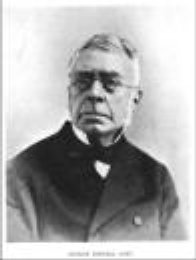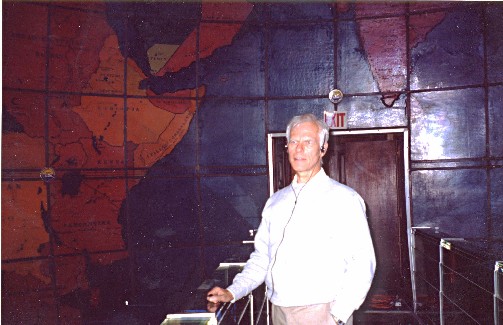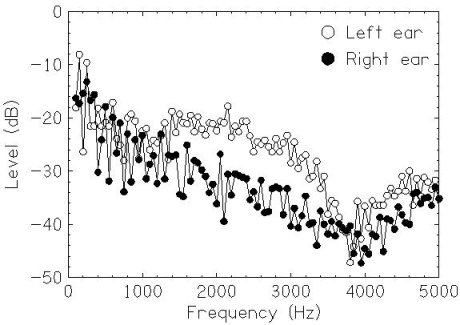|
William Hartmann- hartmann@pa.msu.edu
Popular version of paper 1aAA11
The Mapparium
The Mapparium is a 30-foot walk-through globe made out of glass. Visitors walk on a glass bridge. In this picture you can see the south pole through the bridge. ABSTRACT FROM THE PROGRAMME The Mapparium is a hollow stained-glass globe, 30 feet in diameter, at the Mary Baker Eddy Library in Boston. It allows visitors to see the continents of the world from the perspective of an observer inside the earth. The ears of a visitor walking across the glass bridge traverse a diameter in the equatorial plane. The acoustical nature of this space is of secondary importance, but it is so remarkable that it amazes everyone who experiences it. Extensive listening and recording experiments within the Mapparium (prior to the renovations of 2002) revealed some of the acoustical effects in detail, with source and receiver points near the bridge-diameter. Among the effects are the following: anomalous broad-band point-to-point amplitude transfer functions with maxima (whispering gallery) and spatially-compact minima; localization illusions wherein a source on the listener's left is heard on the right, or high- and low-frequency parts of a sound are localized differently, or sound images change in elevation as the listener walks; spatially-compact regions of flutter echo; and spatially unstable reflections of one's own voice. [Work facilitated by the Mary Baker Eddy Library for the Betterment of Humanity.]
The experimenter is on the glass bridge wearing binaural microphones on his ears. He can move to locations where strange sound localization effects occur and then use the microphones to make a binaural digital recording for analysis back in the lab.
Opposite-ear illusion: The figure shows an analysis of a strange effect. Suppose you are on the Mapparium bridge facing South America (just to the left of Africa shown in the first figure). There is a source of noise to your right, but you discover that you hear the noise coming from your left! The analysis shows why. A band of frequencies, between 1500 and 3500 Hz, is reflected by the sphere to a hot spot at the position of the your left ear. Human listeners interpret such a level difference between the ears as a cue for sound localization. Hot spots: You are on the Mapparium bridge two meters to the left of dead center. Your friend is exactly at the center and is talking to you. His voice seems rather quiet. Now your friend walks away from you, and his voice gets louder and louder until he is about two meters to the right of dead center. At that point of acoustic symmetry, the voice is louder than at any other point - nearly 10 dB more intense. Points of acoustic symmetry are also points of interesting instabilities. Location instability: At points of acoustic symmetry, your perception of the location of a source may become unstable. A perceived location may switch from left to right. Opposite-ear illusions are common but may become unstable as the source changes its orientation. Spectral instability: Any room environment produces effects on the spectra of sounds causing some frequencies to be more prominent than others. Different locations in the room lead to different spectral modifications which are perceived as different tonal colors. In the Mapparium such effects are dramatic because points of acoustic symmetry depend somewhat on frequency.
The top graph shows the spectrum of a buzz measured at the right ear near a point of acoustic symmetry for high frequencies. The bottom graph shows the spectrum measured only about 20 cm away. The increased energy at high frequencies leads to a bright tone color.
Elevation: Perceived sounds in the Mapparium tend to be elevated because of the importance of acoustical power reflected from the dome above. But your perception of elevation is determined by the spectrum at high frequencies, and the sense of elevation that you experience can become unstable as you walk into a symmetry spot where the spectrum changes rapidly. Elevation effects were revealed in controlled perceptual experiments by Christine Mason of Boston University.
Talking to yourself: As you approach the exact center of the Mapparium sphere you suddenly become aware of strong reflections of your own voice. Here, the symmetry point for you as the listener is just the same as the location of you, the talker. If you sway to the left, you hear yourself in your right ear. If you sway to the right, you hear yourself in your left ear.
Whispering gallery: Because opposite ends of the bridge are symmetrically related, the Mapparium is a whispering gallery. Standing at one end of the bridge, you can communicate with a friend at the other end in quiet voices or whispers even though there is lots of interference from other people talking in the room.
In your ear: In normal face-to-face conversation the low-frequency sounds of another's voice bend around your head so that they have about the same intensity in both ears. Only if someone talks directly into one of your ears are low-frequency sounds significantly stronger in one ear compared to the other. Your brain uses this low-frequency difference as a cue that the talker is very close to you. In the Mapparium the low-frequency sounds can be so well focused on one ear that you perceive the talker to be right at your ear, though he may be 30 feet away.

George B. Airy 1801-1892
Fascination with whispering galleries is not new. In 1871, the Astronomer Royal, George Airy, published a theory of the whispering gallery effect as it occurred in the dome of London's St. Paul's cathedral. In a perfectly spherical dome, a sound ray from one side of the center point will be reflected by the dome to a point symmetrically located on the opposite side of center. A few years later, the great Lord Rayleigh criticized Airy's interpretation in article 287 of his massive work, The Theory of Sound. Rayleigh observed that the whispering gallery effect could be heard at all points in the circular gallery that goes around the base of the dome - not just at diametrically opposite points. Rayleigh proposed instead the concept of the creeping wave, which skims along a horizontal periphery of the dome. As a final dig at the Astronomer Royal, Rayleigh noted that the dome of St. Paul's was not really exactly spherical anyway. In the Mapparium, however, we have a dome that really is spherical, and Airy's prediction of a whispering gallery effect between diametrically opposite points holds good. These points do not have to be on the periphery. Any two points located symmetrically on opposite sides of center will work. The Mapparium is Airy's vindication. Here are some links to more information about the Mapparium:
|



